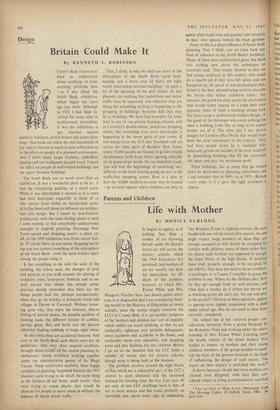Design
Britain Could Make It
By KENNETH I. ROBINSON
The South Bank was so much more than an exhibition. It was a wonderful place to be in : it had the stimulating qualities of a small town. When it was demolished it seemed as if a town had been destroyed—especially to those of us who almost lived within its twenty-nine acres. A lot has been said about its influence on architec- ture and design. But I found no post-Festival architecture with the same feeling about it until I went recently to that remarkably undiscovered example of inspired planning, Stevenage New Town square and shopping centre—a place cut off, as the 1951 exhibition was, from motor traf- fic. If yoU go there on any sunny shopping morn- ing you can capture something of the atmosphere of the South Bank—even the same holiday spirit among the people using it.
It has something to do with the scale of the building, the colour used, the changes of level and patterns as you walk around, the placing of sculpture, trees, lamp-posts, bollards and so on. And anyone who thinks this sounds rather precious should remember that these are the things people look for, perhaps unconsciously, when they go on holiday to favourite towns and villages in Devon or Cornwall. Without know- ing quite why, they enjoy the intimate, shut-in feeling of narrow streets, the surprise qualities of twisting lanes, the different texture of cobbles, paving, grass, flint and brick and the narrow alleyways leading suddenly to large, open vistas.
In old towns these are accidental features. And even at the South Bank such effects were not all deliberate: they were often inspired accidents, brought about amidst all the careful planning by enthusiastic young architects working together under the administrative genius of Sir Hugh Casson. These small-town qualities, these happy accidents of planning, happened because the 1951 planners were trying to do much the same thing as the builders of our better small towns: they were trying to create places that would be pleasant for people to move about in without the menace of heavy motor traffic.
That, I think, is why we shall see more of the atmosphere of the South Bank-Lgood land- scaping and a more cosy (if that's the right word) relationship between buildings—in quite a lot of the planning of the near future. At last planners are realising that pedestrians and motor traffic must be separated, and wherever they are doing this something exciting is happening to the grouping of buildings—however dull they may be as buildings. We have had examples for some time in one or two private housing schemes, and in Coventry's double-decker pedestrian shopping centre; but something even more spectacular is happening in the newer parts of new towns. If you escape from the Ala near Southend and cut across the older parts of Basildon New Town, where 50,000 people are housed in garden-cityish development (with front doors opening absurdly on to green strips beside the car-bedecked road), you will find the beginnings of something very different in the latest housing going up next to the traffic-free shopping centre. Here is a hint of how the 50,000 residents-to-come may be housed —in terraced squares where children can play in
safety while trade vans and parents' cars circulate in their own squares behind the back gardens.
None of this is a direct influence of South Bank planning. Nor, I think, can we trace back any kind of influence to the South Bank's buildings. Many of them were architectural gems, but there was nothing new about the techniques or materials used. They simply showed us that we had young architects in this country who could do a superb job if they were left alone and not hampered by the greed of non-professional men. Greed is the best, all-embracing word to describe the forces that defeat architects today : for instance, the greed for petty power by city fathers who would rather impose on a town their own ignorant views of what a -building should look like than accept a professional modern design, Or the greed of the developer who cares nothing for what a building looks like as long as he makes money out of it. The other day I was shown designs for London office blocks that would have been the most sensational in the country. They had been turned down by a capitalist who habitually grinds the facades of the poor architect by demanding buildings that fill the maximum site space and give the maximum profit.
These buildings, like so many that get turned down by developers or planning committees, are a sad reminder that in 1961—as in 195I—Britain could make it if it gave the right architects a chance.






































 Previous page
Previous page